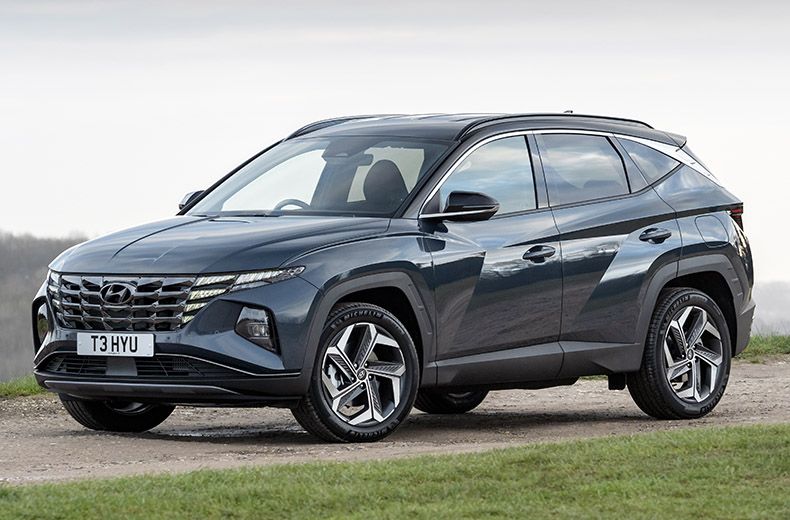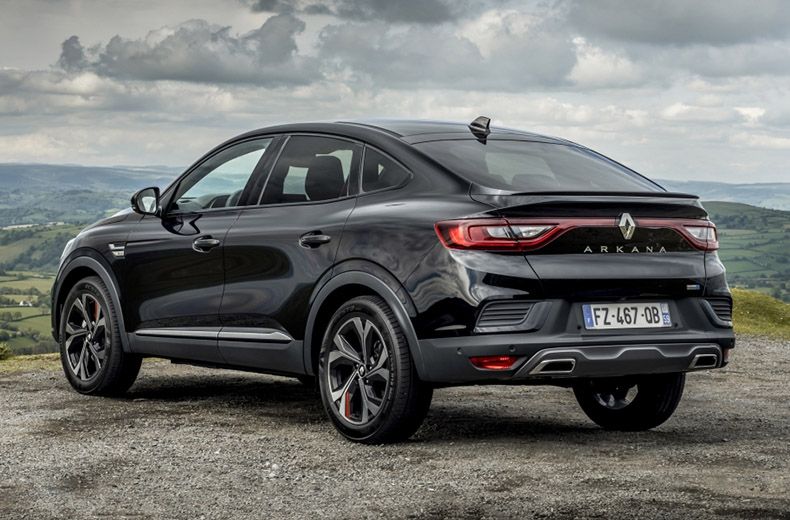So-called ‘self-charging’ hybrid SUVs combine a petrol or diesel engine with an electric motor. Plug-in hybrid SUVs have batteries that can be recharged, and can run on pure electric power for longer distances.
We look at some of the best of both vehicles, including the new Honda HR-V and Renault Arkana.
Best hybrid SUVs
Honda HR-V e:HEV
Without going down the ‘SUV coupe’ route, Honda has given its new HR-V sportier looks than most rivals.
The third generation HR-V also adopts full hybrid technology for the first time. First seen on the larger CR-V SUV and Jazz supermini, this is reflected in the HR-V’s new ‘e:HEV’ (Hybrid Electric Vehicle) suffix.
Its 1.5-litre petrol engine is coupled to a 131PS electric motor, which helps reduce CO2 emissions to 122g/km and provides an official fuel economy figure of 52mpg.
A ‘B’ mode for the eCVT automatic gearbox offers increased regenerative braking to charge the batteries, and can be fine-tuned by using the steering wheel-mounted paddles.
Read our Honda HR-V e:HEV review.

Hyundai Tucson Hybrid
The latest version of Hyundai’s popular Tucson may look like a traditional SUV, but some smart touches mark it out from the hybrid SUV pack.
Its striking styling is a particular highlight. Distinctive front and rear lights mark out the Hyundai even at night.
Similar to other self-charging hybrids, the Tucson is powered by a petrol engine, supplemented by a 60PS electric motor and a 1.49kWh lithium-ion battery.
One of the more powerful self-charging hybrids, total system output is 230PS, which helps the Tucson to 62mph in just eight seconds. There’s even an N-Line model if you want sporty looks to match the zesty performance.
A 265PS plug-in model is offered alongside the regular hybrid. This has an all-electric range of 31 miles.
Read our Hyundai Tucson Hybrid review.

Kia Sorento Hybrid
For pure versatility, very few hybrid SUVs can match the Kia Sorento. Not only can it carry seven people, but when all the rear seats are folded flat, there’s a whopping 1,996 litres of luggage space.
Powered by a 1.6-litre petrol engine, the big Kia also has a 1.49kWh battery and 60PS electric motor. System output is 226PS, and this combination brings CO2 emissions down to 158g/km.
Drive is via a six-speed automatic transmission, and buyers can plump for a plug-in hybrid (PHEV) version as well.
An all-new model, the Sorento’s interior feels pleasingly premium. There’s a large 10.25-inch touchscreen media system on higher trim levels, plus a host of connected driving and safety systems.
Read our Kia Sorento review.

Renault Arkana Hybrid
Among the swathe of hybrid SUVs, the new Renault Arkana Hybrid looks different. That’s because it takes the ‘coupe’ style of several more premium SUVs (the BMW X6, for example) and distils it into a more affordable car.
Its sloping roofline still allows for three rear-seat passengers, though, along with a useful 480 litres of boot space.
The Arkana Hybrid’s 1.6-litre petrol engine uses Renault’s E-Tech technology, developed in conjunction with its Formula 1 team. Like other ‘self-charging’ hybrids, kinetic energy is recovered when decelerating or braking and is used to recharge the hybrid battery – and save fuel.
It boosts overall the official efficiency of the Arkana Hybrid, meaning CO2 emissions of 108-109g/km and fuel consumption of 58.9mpg.
Read our Renault Arkana review.
- How to save fuel – the ultimate guide
- Car tax bands: a simple guide to car tax
- 2030 ban – is it worth buying an electric car now?

Toyota C-HR
If you want a hybrid SUV that really stands out, you may consider the Toyota C-HR. Like the Renault Arkana, it blends SUV and coupe styling to cut quite a dash.
A cocooning cockpit made from good quality materials, plus a plethora of digital technology, adds to the Toyota’s appeal.
Under the C-HR’s shapely bonnet are the same 1.8-litre and 2.0 petrol engines and hybrid technology as the Corolla hatchback. Depending on spec, they offer CO2 emissions of between 110g/km and 128g/km.
A hit with families who want SUV style with practicality, the C-HR’s potential economy of up to 57.6mpg has also won it many friends.
Read our Toyota C-HR review.
RAC Breakdown Cover
Join the RAC and get breakdown cover. Our patrols fix 4 out of 5 vehicles on the spot, with repairs done in just 30 minutes on average.


Best plug-in hybrid SUVs

BMW X5 xDrive45e
Favoured among those who want an SUV that’s dynamic to drive, the BMW X5 plug-in hybrid ticks the efficiency box, too.
An all-electric range of nearly 55 miles is among the longest of any PHEV, and the X5 xDrive45e packs a powerful punch. With 394PS, it’s one of the more potent plug-ins.
A 3.0-litre turbocharged six-cylinder petrol engine, 112PS electric motor and 23kWh battery give the X5 electrifying performance – 0-62mph takes just 5.6 seconds – and incredibly low CO2 emissions of 27-32g/km.
An eight-speed Steptronic transmission puts power down through BMW’s xDrive all-wheel-drive system, whether the X5 xDrive45e is driving on electricity, using its combustion engine, or combining the two.
Read our BMW X5 review.
- Types of electric vehicles – EVs explained
- Electric vehicle range – how far can I drive in an EV?
- The road to electric - in charts and data

Land Rover Range Rover Evoque P300e
Taking Land Rover into more affordable territory, the Range Rover Evoque has established itself as a fashionable SUV force. It’s now more efficient than ever, as a plug-in hybrid version has joined the family.
The Evoque P300e has a 309PS petrol-electric powertrain, which is good for an official 143.1mpg and a zero-emissions range up to 34 miles.
When the Evoque PHEV’s 15kWh battery is empty, it can be recharged to 80 percent capacity in around 30 minutes using a 32kW DC charge point. A 7kW wallbox takes less than two hours to fully replenish it.
Power from the 200PS three-cylinder 1.5-litre petrol engine and 109PS electric motor is managed by an intelligent all-wheel-drive system. On a car with a Range Rover badge – even a plug-in hybrid one – would you expect anything less?

Lexus NX450h+
The new NX450h+ is an important car for Lexus, as the company’s very first plug-in hybrid. But Lexus hasn’t lost its traditional hybrid focus, as the other NX model, the 350h, does without the plug-in tech.
Beneath the bonnet of the NX450h+ is a 2.5-litre, four-cylinder petrol engine that makes 185PS. This is joined by a 185PS electric motor at the front and a 54PS one at the rear.
An 18.1kWh battery helps give the Lexus PHEV an electric-only driving distance of between 43 and 47 miles. In the official test, used for car tax purposes, CO2 emissions are 20-26g/km.
In addition to its upmarket badge, the NX450h+ offers a premium and well-equipped interior as standard. A 14-inch touchscreen and 10-inch head-up display feature on all but the entry-level models.
Read our Lexus NX review.
- Electric car charging – how it works and how much it costs
- Make EV charging easier with the RAC home charge point installation service
- What is a hybrid car and should I buy one?

Mercedes-Benz GLA 250e
Just because it’s the smallest plug-in hybrid SUV Mercedes-Benz makes, that doesn’t mean the GLA 250e skimps on efficiency, practicality, or technology. It also suits those who want a fashionable image.
The GLA 250e is stylish inside, too. All versions have a very slick seven-inch digital instrument display, which flows into a 10.25-inch colour touchscreen media system.
Power comes from a 160PS 1.33-litre petrol engine, a 102PS electric motor and a 15.6kWh battery. They’re good for a system output of 218PS, as well as an all-electric range of around 39 miles.
Charging the battery via a home wallbox takes around three hours, and to help you eke out range, the GLA 250e’s pre-entry climate control allows you to set the cabin temperature while you’re charging, saving energy later on.

Volkswagen Tiguan eHybrid
The second generation of Volkswagen’s Tiguan compact crossover has been as popular as the first. Available in five-seat or seven-seat Tiguan Allspace versions, it plays practicality as its trump card.
However, it deals a good hand when it comes to efficiency, too. The Tiguan eHybrid is a plug-in hybrid SUV. Only available in five-seat configuration, it offers 245PS and a six-speed DSG automatic gearbox.
Emissions range from 38g/km to 41g/km, with fuel economy up to 176.6mpg and an all-electric range of around 30 miles. Another key stat is the boot space of 615 litres – enough for a family holiday.
Read our Volkswagen Tiguan eHybrid review.
The RAC is leading the way when it comes to supporting drivers in the switch to electric vehicles.
A growing number of our patrol vans have built-in emergency mobile charging systems that can give an out-of-charge electric car enough power to be driven a short distance home or to a working charge point. Our All-Wheels-Up recovery system also allows our patrols to rescue electric cars safely, with no need for a flatbed.










